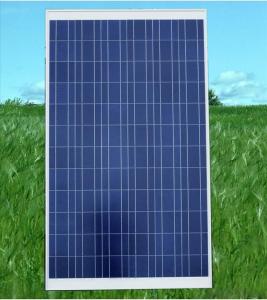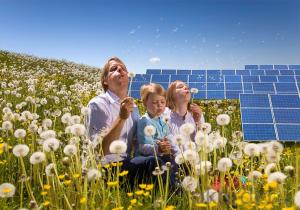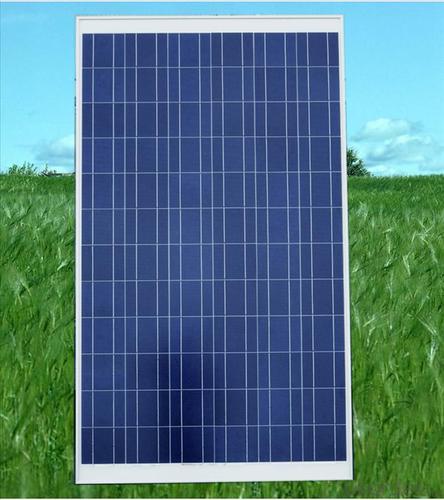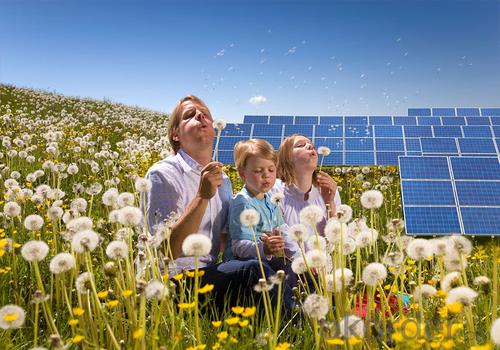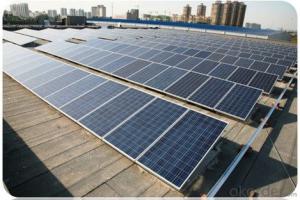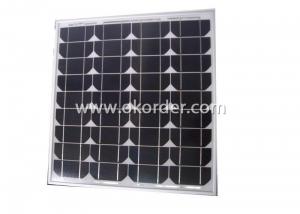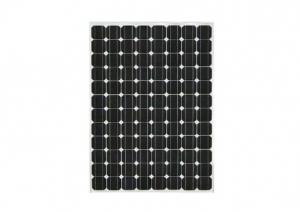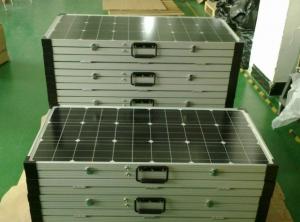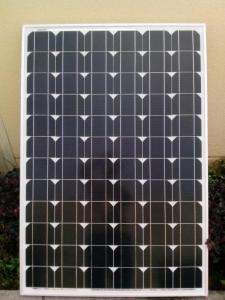260w Polycrystalline Silicon Solar Panels for 2000 Sq Ft Home
- Loading Port:
- Ningbo
- Payment Terms:
- TT OR LC
- Min Order Qty:
- 200000 watt
- Supply Capability:
- 20000000 watt/month
OKorder Service Pledge
OKorder Financial Service
You Might Also Like
About us
We are a high-tech group wich specializes in solar products design,research, manufacture, sales,solar projects design and installation.
Our present annual capacity is 6 million for wafer, 60MWp for solar cells,200MWp for solar modules and one hundred thousand for solar applications. It is expected that the annual capacity of 2012 will be up to 30 million for wafer, 300MWp for solar cells, 1000MW for solar modules and 2 million for solar applications.
INTRODUCTION
This installation Manual contains essential information for the electrical and mechanical installation that your must know before installing CUSTOMER PV modules. This also contains safety information you need to be familiar with .All the information described in this manual are the intellectual property of CNBM and based on the technologies and experiences that have been acquired and accumulated in the long history of CUSTOMER. This document does not constitute a warranty, expressed or implied.
CUSTOMER does not assume responsibility and expressly disclaims liability for loss, damage, or expense arising out of in anyway connected with installation, operation, use or maintenance of the PV modules. No responsibility is assumed by CUSTOMER for any infringement of patents or other rights of third parties that may result from use of PV module.
CUSTOMER reserves the right to make changes to the product, specifications or installation manual without prior notice.

GENERAL INFORMATION
The installation of PV modules requires a great degree of skill and should only be performed by a qualified licensed professional, including licensed contractors and licensed electricians. Please be aware that there is a serious risk of various types of injury occurring during the installation including the risk of electric shock. All CUSTOMER modules are equipped with a permanently attached junction terminal box that will accept variety of wiring applications or with a special cable assembly for ease of installation, and they do not require assembly.
WORK PRINCIPLE
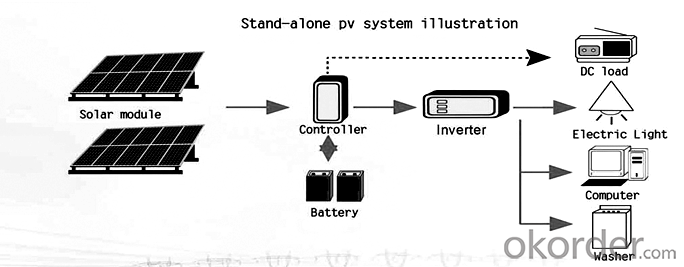
Data sheet
Maximum power | 260W |
Cell type(mm) | Polycrystalline solar cell 156*156 |
Number of cell(pcs) | 60(6*10) |
Manufacture site | China |
Open-circuit voltage(voc) | 37.6V |
Maximum power voltage(vmp) | 30.5V |
Short-circuit current(isc) | 8.95A |
Optimum operating current(imp) | 8.53A |
Power tolerance | 0~+5W |
Module efficiency | 16% |
Dimensions(mm) | 1640*992*40 |
Weight | 19 kg |
Backsheet | Silver |
Frame Colar | White |
Frame | Anodized Aluminum Alloy |
SITE SELECTION
In most applications, the PV modules should be installed in location where there is no shading throughout the year. In the Northern Hemisphere, The PV modules should typically face south, and in the Southern Hemisphere, the PV modules should typically face north. Please make sure that there are no obstruction in the surroundings of the site of installation. Take proper steps in order to maintain reliability and safety, in case the PV modules are used in areas such as: Heavy snow areas/Extremely code areas/ Strong wind areas/Installation over, or near, water/ Areas where installations are prone to salt water damage (*)/Small islands or desert areas.(*)
If you are planning to use the PV modules where the salt water damage may be possible consult with CNBM local agent first to determine an appropriate installation method, or to determine whether the installation is possible?
- Q: How do solar panels affect the power grid?
- Solar panels can have both positive and negative effects on the power grid. On the positive side, when solar panels produce excess electricity, it can be fed back into the grid, increasing the overall supply of electricity. This can help reduce the demand on traditional power plants and decrease greenhouse gas emissions. However, the intermittent nature of solar power can also introduce challenges to the grid, as it can cause fluctuations in electricity supply. To mitigate this, grid operators need to carefully manage and balance the overall energy mix to ensure a stable and reliable power supply.
- Q: I am researching several solar panels to install in my house. I would like to use a 40 watt panel to connect, through a solar battery controller, to a battery or two. I would then like to use the solar panel (40 watts) to charge the battery(ies) for emergency use. Once charged, and when needed, I would like to use the battery(ies), 2 volt deep cycle, to power several LED lamps. Since I am new to solar power I had several questions...Is a 40 watt panel strong/large enough to charge a 2 volt deep cycle battery or two?How long would it take to charge one of these batteries?What would be the expected cost to purchase necessary supplies? (With the solar panel, battery controller, and MC4 cabling I've found I have an expected cost of roughly $00.00 with batteries)Would this be difficult for someone with little experience in this field?
- Your demand is high. You require at least 5KVA (5000watts) out put with an appropriate battery storage and inverter..
- Q: Can solar panels be used to power a theme park?
- Yes, solar panels can be used to power a theme park. Solar panels can generate electricity from sunlight, providing a sustainable and renewable energy source. By installing a sufficient number of solar panels, a theme park can meet its energy needs and reduce its reliance on traditional power sources, contributing to environmental sustainability.
- Q: Can solar panels be connected directly to motor?
- The sun is irradiated on the semiconductor p-n junction to form a new hole-electron pair. Under the action of the p-n junction electric field, the holes flow from the n region to the p region. The electrons flow from the p region to the n region, and the current is formed after the circuit is turned on.
- Q: This is the cenario. Your yearly energy use comes by mail and it states that the total amount of energy used your household is 7000kWh.Then you make the decision of switching to get solar panels. The question is what area should your solar panel be given that the average annual length of daylight is 2.0.
- It is not that simple. There are 3 main types of solar cells. Monocrystalline silicon is the most efficient and produces the smallest solar cells, and therefore the smallest panels. Poly-crystalline (or multi-crystalline) silicon produces the next most efficient type of cells and are a popular choice. Amorphous (or thin-film) silicon uses the least amount of silicon and also produces the least efficient solar cells. This means thin film system take up more area than the other two; an important factor to consider in relation to possible future upgrades; i.e. if you'll have enough space left to do so. The North (in the Southern hemisphere) or South (in the Northern hemisphere) facing roof collects the most energy. So this biases the roof area required. Your energy usage can be changed. Hot water (a major energy user) could be better using direct solar heating with peak demand boosting, either from mains or solar. There are other possibilities, either to reduce demand or to provide energy from other sources. Not all sunshine hours are equal. Hours around midday are far more productive than hours later in the day. This must be factored in.
- Q: What is the principle of solar panels to convert solar energy into electricity?
- When the light is irradiated on the surface of the solar cell, a part of the photon is absorbed by the silicon material; the energy of the photon is transferred to the silicon atom, so that the electrons are moved and the free electrons are formed on both sides of the P-N junction to form a potential difference. When the circuit is used, the current will flow through the external circuit to produce a certain output power. The essence of this process is the process of converting the energy of the photon into electrical energy.
- Q: Can solar panels be installed on a billboard or signage?
- Yes, solar panels can be installed on billboards or signage.
- Q: Also, what's the solar panel's rate of producing electricity?
- Solar panels really can't compete with fossil fuels of any kind. They're great for low power consumption applications, but I doubt we'll ever see solar powered steel refineries or heavy manufacturing plants. A solar panel that produces 75 watts is about 62 x 33 (5 feet by almost 3 feet). 75 watts is enough to power a couple light bulbs; you'd certainly never cook anything on it. On the other hand consider how much heat and light is produced by a small natural gas fireplace or stove burner. It would take a lot of those 5 foot long solar panels to equal that.
- Q: How do solar panels affect the overall sustainability of a building?
- Solar panels can significantly enhance the overall sustainability of a building by generating clean and renewable energy. By harnessing the power of the sun, solar panels reduce the reliance on fossil fuels, resulting in lower greenhouse gas emissions and a smaller carbon footprint. Besides producing electricity, they can also provide heating and cooling, further reducing energy consumption. Additionally, solar panels contribute to energy independence, improve energy efficiency, and can even generate excess power that can be stored or fed back into the grid. Overall, solar panels play a crucial role in promoting sustainable practices and mitigating climate change impacts.
- Q: Can solar panels be used for off-grid living?
- Yes, solar panels can be used for off-grid living. They are a popular and sustainable option for generating electricity in remote areas or locations where there is no access to the traditional power grid. Solar panels collect energy from the sun and convert it into usable electricity, which can power various appliances and systems in an off-grid home. Additionally, by incorporating batteries or other energy storage solutions, solar panels can provide a consistent power supply, even during periods of low sunlight or at night.
Send your message to us
260w Polycrystalline Silicon Solar Panels for 2000 Sq Ft Home
- Loading Port:
- Ningbo
- Payment Terms:
- TT OR LC
- Min Order Qty:
- 200000 watt
- Supply Capability:
- 20000000 watt/month
OKorder Service Pledge
OKorder Financial Service
Similar products
Hot products
Hot Searches
Related keywords
